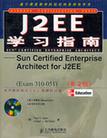J2EE学习指南
出版时间:2003-8 出版社:第1版 (2003年8月1日) 作者:(美)艾伦,(美)班泊拉 著 页数:618 字数:901000
Tag标签:无
内容概要
本书以Sun认证Java 2企业级设计师(SCEA for J2EE)认证考试为目标,内容涵盖了SCEA(J2EE)核心考试的所有考试要点,详细介绍了参加SCEA(J2EE)的应试者以及J2EE高级用户所应该掌握的技能。 本书在介绍考试要点时针对每个考试目标,使用了大量的插图、表格、试验、测试等,使读者在牢固掌握知识点的同时,轻松地获得丰富的实践经验。 本书由具有丰富SCEA(J2EE)考试经验的专家编写,是参加SCEA(J2EE)的考试人员的必备考试教材。本书也是一本学习使用和管理J2EE的很好的参考书,还可以作为一些疑难问题的速查手册。
书籍目录
1 Sun Certification for Enterprise Architect Widespread Capabilities for Application Development Java Is the Glue That Binds the Application Development Process Companies Increasingly Need the Internet to Compete Challenges of Application Development for the Enterprise Increasing Programmer Productivity J2EE Architecture Must Respond to Consumer Demand The Architect Must Be Able to Integrate J2EE and Legacy Systems The J2EE Standard Promotes Competition and Choices Design Goals of J2EE Architecture J2EE Architects Should Strive for Service Availability J2EE Architecture and Connectivity to Existing Data Expanded User Definition: Customers, Employees, and Partners Flexible User Interaction Flexible Business Component Model Sun Certified Enterprise Architect Distinguishes the Java Professional General SCEA Test Preparation Tips 2 Common Architectures and Protocols Types of Architecture System Architecture Reference Architecture Flexible Reference Architecture Architectural Design and Principles Where Architecture Fits in Analysis, Design, and Development 28 Architectural Terminology Abstraction Surface Area Boundaries Brittleness Capabilities, Friction, and Layering Principles of Architecture Layering Tiers Capabilities of an Architecture Creating an Architecture Using Distributed Services and J2EE Enterprise JavaBeans Distributed Application Lifecycle Iterative Development/MVC Simplified Architecture and Development Component-Based Application Models J2EE APIs and Certification J2EE Specification J2EE Reference Implementation Sun BluePrint Design Guidelines for J2EE XML and J2EE Why Use XML? Electronic Data Exchange and E-Commerce Electronic Data Interchange(EDI) Enterprise Application Integration(EAI) Software Development and XML XML Technology and the Java Platform Distributed Programming Services Naming and Registration Remote Method Invocation(RMI) Protocols Distributed Object Frameworks Given an Architecture Described in Terms of Network Layout, List Benefits and Potential Weaknesses Associated with It Exercise 2-1: Role of Architect Exercise 2-2: Architecture Terminology Exercise 2-3: Abstraction, Boundaries, Brittleness, and Capabilities Exercise 2-4: Fundamentals of System Architecture Exercise 2-5: Abstraction √Two-Minute Drill Q&A Self Test Self Test Answers 3 Object-Oriented Analysis and Design 4 Applicability of J2EE Technology 5 Design Patterns 6 Legacy Connectivity 7 Enterprise JavaBeans and the EJB Container Model 8 Messaging9 Internationalization and Localization 10 Security11 Case Study: Overview of Securities Trading System 555GlossaryA About the CDIndex
图书封面
图书标签Tags
无
评论、评分、阅读与下载
